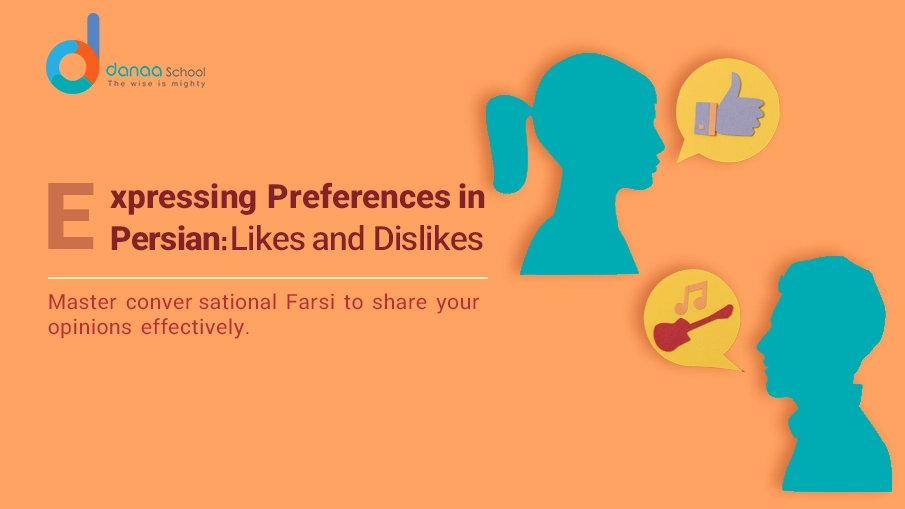Mastering how to express likes and dislikes in Farsi is essential for improving conversational skills and building deeper connections with Iranian culture and people. In this guide, we’ll explore vocabulary, pronunciation tips, cultural nuances, and common phrases in Farsi confidently express your preferences in Farsi. Whether you’re a beginner or brushing up on your skills, you’ll find this resource invaluable.
What Are Likes and Dislikes in Farsi?
In Farsi, expressing likes and dislikes revolves around verbs like “دوست داشتن” (doost dashtan, to like) and “دوست نداشتن” (doost nadâshtan, to dislike). Learning these expressions enables meaningful conversations about hobbies, food, activities, and more.
Why Learn Likes and Dislikes in Farsi?
-
- Connect with Native Speakers: Discussing personal preferences helps break the ice.
-
- Enhance Cultural Understanding: Preferences often reveal cultural values and traditions.
-
- Improve Conversational Farsi: Knowing these expressions makes everyday dialogue smoother.
Basic Vocabulary for Likes and Dislikes in Farsi
| English | Farsi (Persian) | Pronunciation |
| I like | من دوست دارم | man doost dâram |
| I don’t like | من دوست ندارم | man doost nadâram |
| Love | عشق | eshgh |
| Hate | نفرت | nefrat |
| Favorite | مورد علاقه | mored-e alâqe |
Examples:
-
- I like reading: من خواندن را دوست دارم (man khândan râ doost dâram).
-
- I dislike spicy food: من غذای تند را دوست ندارم (man ghazâye tond râ doost nadâram).
How to Pronounce Likes and Dislikes in Farsi
Pronunciation is key to making your Farsi sound natural. Here are some tips:
-
- Stress Syllables: In doost dâram, stress the first syllable of “doost.”
-
- Soft ‘R’ Sounds: Roll the “r” slightly, but not as strongly as in Spanish.
-
- Practice Common Phrases: Repetition helps cement the sounds in your mind.
Cultural Insights on Likes and Dislikes in Iranian Contexts
- Hospitality and Preferences
Iranians value hospitality, so expressing likes and dislikes politely is crucial. For example, if offered tea, you can say:
-
- من چای را دوست دارم (man chây râ doost dâram) – I like tea.
-
- من قهوه را بیشتر دوست دارم (man ghahve râ bishtar doost dâram) – I prefer coffee.
- Politeness Matters
When declining something, use soft language. Instead of saying “I hate this,” opt for دوست ندارم (doost nadâram), which is less harsh.
How to Talk About Your Likes and Dislikes in Farsi
- Expressing Like
To say you like something, use دوست دارم (doost dâram) followed by the object or activity.
Examples:
-
- I like Iranian movies: من فیلمهای ایرانی را دوست دارم (man film-hâye irâni râ doost dâram).
-
- I love learning Farsi: من عاشق یادگیری فارسی هستم (man âsheq-e yâdgiri fârsi hastam).
- Expressing Dislikes
To express dislikes, simply negate the verb: دوست ندارم (doost nadâram).
Examples:
-
- I don’t like traffic: من ترافیک را دوست ندارم (man terâfik râ doost nadâram).
-
- I dislike cold weather: من هوای سرد را دوست ندارم (man havâye sard râ doost nadâram).
Find Your Ideal Teacher
At Danaa School, you can choose your Farsi tutor from a selection of qualified and experienced teachers. Begin an exceptional journey into the world of Persian language!
Book Your Trial Lesson
Conversational Farsi: Practical Phrases for Likes and Dislikes
- Talking About Food
Do you like kebab?
آیا کباب را دوست دارید؟ (âyâ kabâb râ doost dârid?)
I like kebab very much:
من کباب را خیلی دوست دارم (man kabâb râ kheili doost dâram).
- Discussing Hobbies
What do you like to do?
شما چه کاری را دوست دارید انجام دهید؟ (shomâ che kâri râ doost dârid anjâm dahid?)
I like painting:
من نقاشی را دوست دارم (man naghâshi râ doost dâram).
Likes and Dislikes in Farsi: Iranian Perspective
Understanding preferences in Iranian culture can deepen your appreciation of their traditions. For example:
- Popular Likes: Tea, poetry (especially by Hafez and Rumi), and gatherings with family.
- Common Dislikes: Wasting food and lack of respect for elders.
Tips for Learning Likes and Dislikes in Farsi
- Use Flashcards: Practice vocabulary daily.
- Watch Iranian Media: Movies and shows often use conversational Farsi.
- Engage with Native Speakers: Test your skills in real-life scenarios.
Practice Makes Perfect: Role-Playing Likes and Dislikes
Create scenarios to practice:
- Scenario 1: Discussing favorite foods at a Persian restaurant.
- Scenario 2: Talking about hobbies with a language exchange partner.
FAQs
How do you say "I love you" in Farsi?
You say دوستت دارم (doostet dâram), which means “I love you.”
What’s the difference between "like" and "love" in Farsi?
“دوست داشتن” (doost dashtan) means “to like,” while “عاشق بودن” (âsheq budan) refers to being in love or loving deeply.
How can I politely say I don’t like something?
Use دوست ندارم (doost nadâram) followed by the item or activity. For example, من شیرین را دوست ندارم (man shirin râ doost nadâram) – I don’t like sweets.
Are likes and dislikes gender-specific in Farsi?
No, verbs like دوست داشتن and دوست نداشتن are not gender-specific, though personal pronouns can indicate the subject’s gender.
How can I practice pronunciation for Farsi likes and dislikes?
Listening to native speakers on platforms like YouTube or engaging in language exchanges is highly effective.
What are some fun ways to learn conversational Farsi?
Try watching Iranian dramas, cooking Persian recipes, or joining Farsi-speaking groups online.
Conclusion
Expressing likes and dislikes in Farsi is a vital step in becoming conversationally fluent. By mastering the vocabulary, practicing pronunciation, and understanding cultural nuances, you’ll connect more deeply with the language and its speakers. Consistency is key—immerse yourself in the language and make learning a daily habit. Sign up now
Want to Learn Farsi at Danaa School?
Here are the best resources for you!








